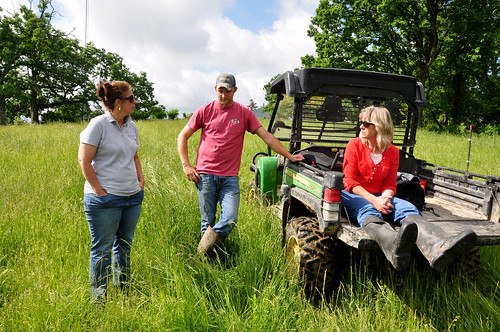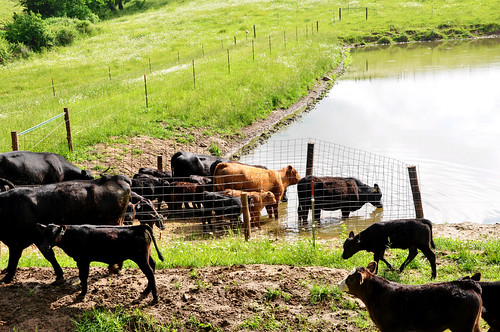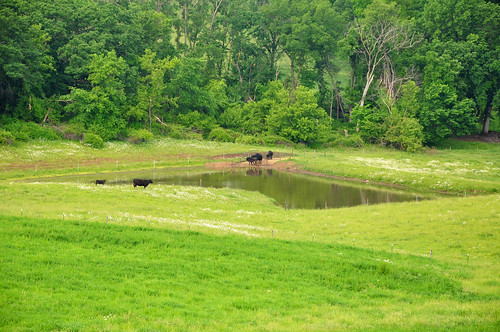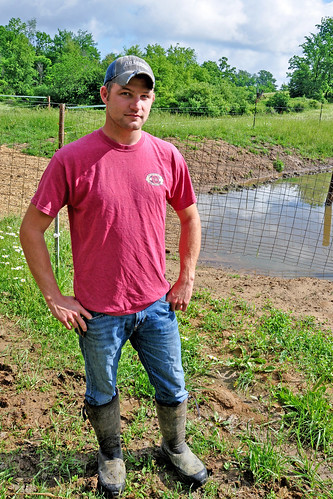
Ryan Collins (center) stopped to meet with NRCS District Conservationist LuAnn Rolling (right) and Iowa NRCS State Public Affairs Specialist Laura Crowell June 1 at his farm near Harpers Ferry. Photo: Jason Johnson.
When Iowa livestock producer Ryan Collins bought his 170-acre farm near Harpers Ferry, he knew from experience with USDA’s Natural Resources Conservation Service (NRCS) that the agency could help him plan a rotational grazing system.
A rotational grazing system—also known as prescribed grazing—divides pastures into four or more small paddocks with fencing. The animals move from paddock to paddock on a schedule based on the availability of forage and the livestock’s nutritional needs.
Collins says he has a lot more grass available than before. “I attribute it to the rotational grazing,” he said. “I like to have plenty of grass. The cows and calves both do, as well.”
When he first contacted NRCS for assistance, Collins assumed he would only receive help with fencing for his new grazing system. Today, however, he works regularly with NRCS staff – including District Conservationist LuAnn Rolling – to develop and implement his plan that is helping him better manage his grasslands, keep his cattle healthy and productive, and protect the natural resources on his farm.

Ryan Collins has 35 cow/calf pairs grazing his 170 acres near Harpers Ferry in northeast Iowa. Photo: Jason Johnson.
“I didn’t realize there were so many practices available for funding through EQIP (Environmental Quality Incentives Program) until I started working with LuAnn,” said Collins. EQIP provides agricultural producers financial and technical assistance to implement structural and management practices that optimize environmental benefits on working agricultural lands. NRCS provided about $16.4 million to Iowa farmers in fiscal year 2015.
As a beginning farmer—group USDA considers historically underserved—Collins received higher payment rates than most farmers for the conservation practices he installed.
Pond Access Ramp
One of the practices Rolling recommended—a limited-access ramp for ponds—is Collins’ key to watering his cattle. Design of the rotational grazing system called for three of five paddocks to utilize an existing pond for drinking water. Rolling also recommended fencing off the pond to prevent erosion and pond degradation, while allowing livestock to drink directly from it from a fenced access ramp.
One of the practices Rolling recommended—a limited-access ramp for ponds—is Collins’ key to watering his cattle. Design of the rotational grazing system called for three of five paddocks to utilize an existing pond for drinking water. Rolling also recommended fencing off the pond to prevent erosion and pond degradation, while allowing livestock to drink directly from it from a fenced access ramp.

Cows use the fenced access ramp to drink water from one of three paddocks available to the pond. Photo: Jason Johnson.
Rolling says livestock should almost always be excluded from streams and ponds. “Allowing unlimited access to water sources like ponds and creeks can be dangerous and unhealthy for animals,” she said. “Cattle can get foot rot and leg injuries. Plus, cattle prefer clean water.”
Rolling says keeping animals out of ponds extends pond life, too, allowing bank vegetation to grow. This keeps water cleaner by reducing sediment and nutrient runoff.
The entire access ramp is 40-feet long with a gradual 8:1 slope. A contractor installed geo-textile, covered it with 3- to 9-inch rock, and topped it with 2- to 3-inch rock. The 15-foot by 15-foot drinking area is covered in water. “The ramp is very solid and stable, and won’t erode,” said Collins.
Other Practices and Maintenance
As part of the rotational grazing system, Collins installed more than 7,000 feet of permanent barbed wire multi-strand fence and 3,500 feet of permanent high-tensile fencing.
As part of the rotational grazing system, Collins installed more than 7,000 feet of permanent barbed wire multi-strand fence and 3,500 feet of permanent high-tensile fencing.
Family Farm Upgrades
Collins is so pleased with the new conservation practices on his farm that he’s working with his father to implement some of the same practices on the family farm. “We are going to convert some cropland to pasture to more easily connect two farms for a rotational grazing system,” he said.
Collins is so pleased with the new conservation practices on his farm that he’s working with his father to implement some of the same practices on the family farm. “We are going to convert some cropland to pasture to more easily connect two farms for a rotational grazing system,” he said.
They are also planning to install limited-access ramps on livestock watering ponds, as well as two new watering facilities.
For more information about conservation planning and programs for your farm, visit your local NRCS office or go to www.ia.nrcs.usda.gov.

Ryan Collins of rural Harpers Ferry stands near his new limited access pond ramp, which only allows his cow/calf herd to drink from that portion of the pond. Photo: Jason Johnson.
No comments:
Post a Comment
Note: Only a member of this blog may post a comment.